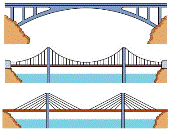Civil and Environmental Engineering, Department of

Department of Civil and Environmental Engineering: Faculty Publications
Document Type
Article
Date of this Version
1-2000
Citation
WATER RESOURCES RESEARCH, VOL. 36, NO. 1, PAGES 335-348, JANUARY 2000
Abstract
Unsteady flows are ubiquitous in nature. In order to understand the behavior of sediment when subjected to unsteady flows, a set of experiments was performed in a rectangular duct with a mobile bed. A computer-operated vale governed the velocity of the water in the duct, and the flow velocity, wall shear stress, and vertical distribution of suspended sediment were simultaneously measured. Beds composed of 120 um and 580 um diameter sand were investigated. Both quasi-steady flows and pulse flows were investigated. Both quasi-steady flows and pulse flows were simulated in the duct. For the pulse flows the water was accelerated at a constant rate to a peak velocity and then decelerated at a constant rate to zero velocity. Phase lags were observed between the bed shear stress and the upward flux (entertainment) of sand from the bed. The phase lags were larger for tests with fine sand than for tests with coarse sand. Differences were attributed to differences in the bed roughness and flow Reynolds numbers. Relations based on flow acceleration and sediment size were developed for predicting the entertainment phase lag. Large phase lags can have a considerable impact on the amount of sediment transported by boat wakes, and other unsteady flows.


Comments
2000 by the American Geophysical Union